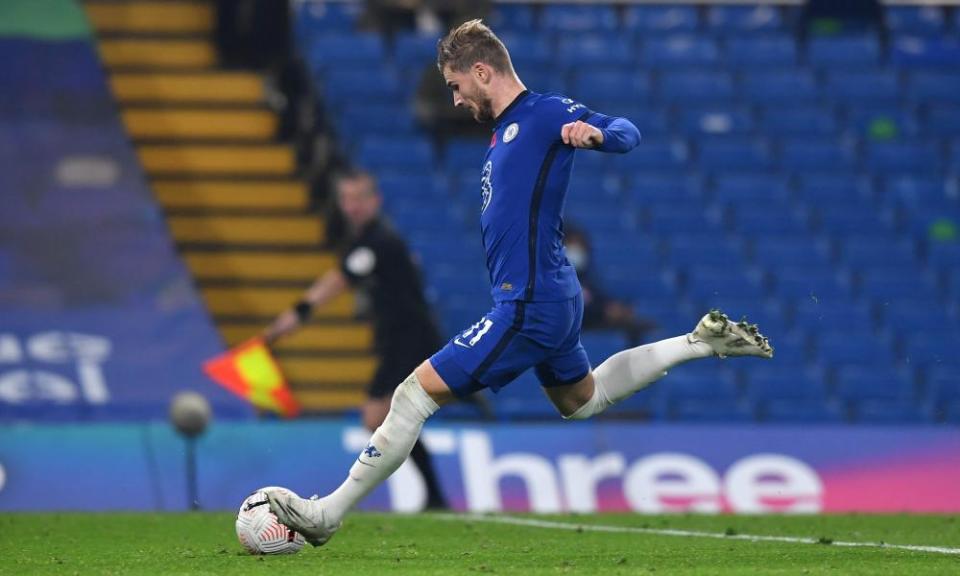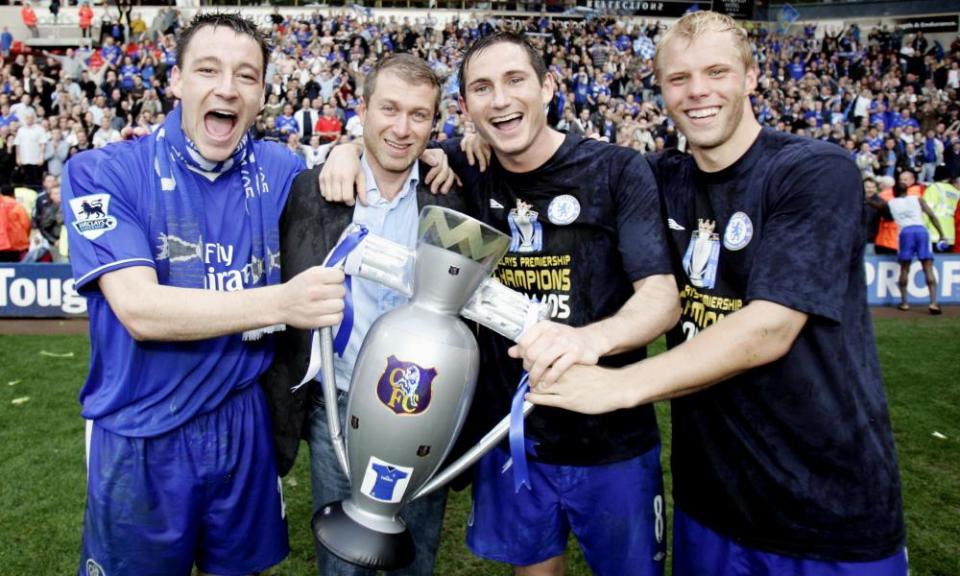Frank Lampard resists title talk but knows intensity of Chelsea demands
Sunday’s game against Tottenham will be Roman Abramovich’s 1,000th as Chelsea owner. There probably won’t be a cake. Nor should we expect much in the way of a lavish presentation, given that the supreme leader himself hasn’t been glimpsed at a home game in two and a half years. And yet as Abramovich watches on from afar – presumably from his Moscow palace, surrounded by objets d’art and luxury snacks – he may reflect that this is a curiously appropriate fixture to mark the occasion. It is, after all, a meeting between the two men who have arguably defined his 17 years in English football more than any other. His favourite player, and his favourite manager.
Related: My Premier League team of the season so far | Barry Glendenning
As a player and coach, nobody has been involved in more of those 999 matches than Frank Lampard. Even now, he has scored 10% of all Chelsea’s goals in the Abramovich era. As a manager, he has already lasted 70 games, which by Abramovich standards is practically old age. Given a couple of decent cup runs, he should overtake Antonio Conte and Carlo Ancelotti before the end of the season. By which point, only one name will sit above him on the list.

In a way it was José Mourinho, the very first Abramovich appointment back in 2004, who would set the tone for all the others: not simply the expectation of success but the means of achieving it. The first Mourinho dynasty blew in like a typhoon, and blew out just as quickly: an era of shock therapies and quick fixes and trophies dropping from the sky like rain. Everything that followed seemed a logical progression from that first, scintillating hit of pure mayhem.
And yet. Take a step back, and the two longest managerial tenures of the Abramovich era are still Mourinho I (2004-07) and Mourinho II (2013-15). José, as it turned out, wasn’t the chaos. The chaos was everything else. Perhaps it gets forgotten amid the feuds, the sackings, the bared claws, the pervading sense of menace. But Mourinho was actually the closest Abramovich-era Chelsea ever got to stability.
Until now, perhaps. In the 13 years since Mourinho’s first sacking, Lampard is the manager who has come closest to challenging the ceaseless Abramovich cycle of boom and bust. He is by no means the first of Abramovich’s “project managers”, appointed not simply to win trophies but to establish a defined identity, to build something. But he is the first to get this sort of time and this sort of backing. There are two possible ways of reading this.
First, that Abramovich himself has taken his foot off the gas. This is a theory that has been doing the rounds for a while now. And yet, committing more than £200m to transfers during a pandemic is hardly the act of an absentee owner going through the motions. Which brings us to the second, more intriguing possibility: that he has been studying Lampard’s work, and likes what he sees.

Nine games into the season, Chelsea are the Premier League’s top scorers: cautiously improving while most of their rivals are regressing. The arrivals of Thiago Silva and Ben Chilwell have tightened up the back five. Hakim Ziyech, Timo Werner and Kai Havertz have given them delightful new dimensions in attack. The press appears to be fully functional. They no longer have a goalkeeper who looks haunted and broken. All of which, some argue, puts Chelsea in the title frame.
Naturally, Lampard has not been touching that one with a bargepole. And yet already he seems to have exceeded the meagre expectations invested in him when he took the job last year in the middle of a transfer ban and steered Chelsea judderingly into the top four. Already this season his smooth, frictionless 4-3-3 – with N’Golo Kanté back at the base of midfield – feels more disciplined and structured than in Lampard’s riotous first season, when every counterattack felt like a strip search, every set piece like a crisis.
Related: Frank Lampard makes case for the defence as forwards take back seat | Jacob Steinberg
The restoration of Kanté to the midfield sentinel role has been integral to all this. So far this season, he has not made a single tackle in the final third. His shots and key passes have nosedived. But the trade-off has been divinely worthwhile: more defensive interventions, more pressure on the ball, more of the quick switches that keep Chelsea ticking over.

Perhaps there are some stylistic similarities here with Mourinho’s first Chelsea team, one Lampard himself played in: a structured 4-3-3 with Claude Makélélé in the Kanté role and two roaming wingers in Damien Duff and Arjen Robben. There is a tonal similarity between the two men as well: the sort of charming ruthlessness that allows you to cajole players with one hand and cut them adrift with the other.
The churn from last season has been remarkable: of the six most-frequent starters from 2019-20, only Mason Mount remains a first-choice. Along the way almost an entire team has been discarded or sidelined: César Azpilicueta, Fikayo Tomori, Ross Barkley, Pedro, Marcos Alonso, Willian, Antonio Rüdiger, Andreas Christensen, the poor, wretched Kepa Arrizabalaga in goal.
It says something of Lampard’s resilience – or perhaps his self-regard – that he has shown virtually no ill-effects
Already Chelsea have used 26 players this season, more than any other team in the Premier League. And while you could just as easily take this as evidence of Chelsea’s enviable strength in depth and their ability to simply buy their way out of trouble, keeping the plates spinning at a club of Chelsea’s size and sanity has always been a harder job than it looks.
“We all have pressure,” Lampard retorted on Friday to Mourinho’s suggestion that Chelsea’s spending demanded instant results. But more experienced managers than Lampard will tell him that the madness of Chelsea invariably claims you before long. Maurizio Sarri ended up bruised and fractious, Conte wired and paranoid, Avram Grant sad and crumpled, like a man living out of the back of his Renault. It says something of Lampard’s resilience – or perhaps his self-regard – that he has shown virtually no ill-effects so far.
But then, this is the pattern of the Abramovich years: things are as they are; right up until the moment they aren’t. Chelsea are a club where the floors shift quickly, where the walls push back at you: a realm of the ruthless, and having paced their corridors for 15 years Lampard will know that better than anyone. He will know that no manager has ever survived two seasons under Abramovich without winning the Premier League title. He knows he might never get a better chance, but he also knows he might never get another.

 Yahoo Movies
Yahoo Movies 
